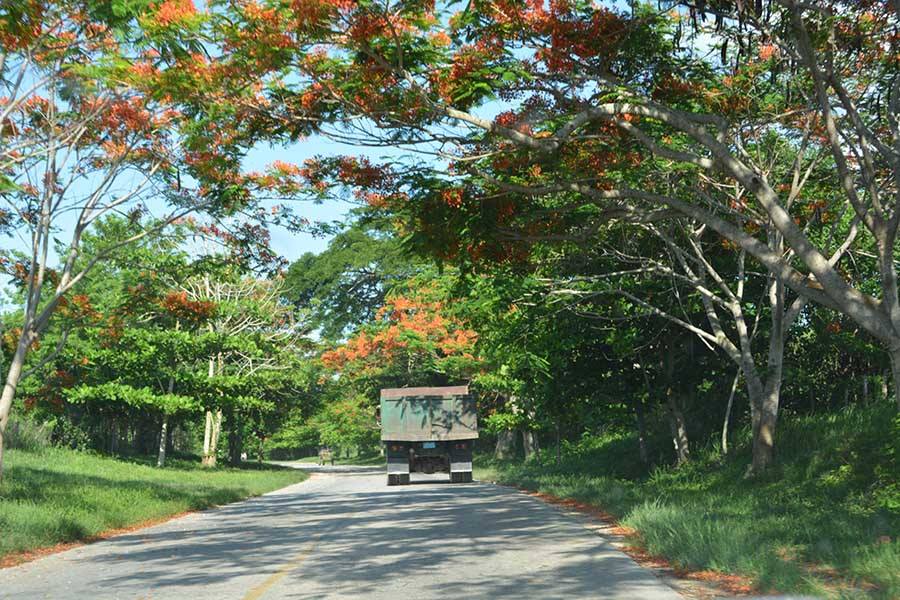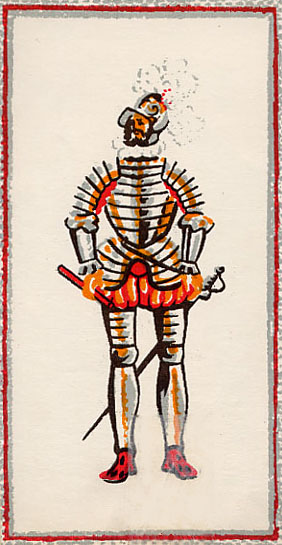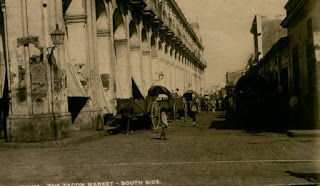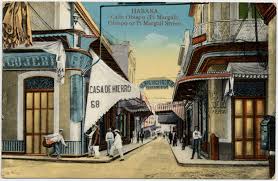LA HABANA: TIEMPOS DEL CALZÓN Y ESPADA AL CINTO.
Los hombres vestían calzón corto y era obligatorio llevar espada al cinto, y las señoras usaban mantillas y mantas. Era carísima la indumentaria tanto del hombre como de la mujer.
El mobiliario era muy primitivo; abundaba lo que se llamó durante siglos el taburete de cuero. Los muebles consistían en bancos y asientos de cedro o caoba, sin espaldar. La cama era una armazón con cuatro patas que cubrían con una pieza de lona o cuero crudo. Era el lecho de la gente pobre. La gente acomodada mandaba a Castilla el ébano y el granadillo, maderas preciosas abundantes aquí, y de allí recibían ricos dormitorios con camas imperiales. En todas las salas había un cuadro de devoción al que, de noche, se le encendían luces para las plegarias. Las familias se alumbraban con velas de sebo. Los ricos usaban velones de cera traídos de Sevilla y que alimentaban con aceite de oliva.
Hacia 1560 solo dos comerciantes habaneros pagaban sus impuestos y contribuciones al Cabildo, y se hacía muy difícil conseguir quien acometiese lo que entonces se llamaba «trabajo de mano» —sastres, carpinteros, zapateros, etc.— y los que lo hacían pedían a cambio sumas prohibitivas.
La urbanización de La Habana en los comienzos del siglo XVII era muy pobre. De la Plaza de Armas partían dos calles bien alineadas, la de Oficios y la de Mercaderes y ambas iban a encontrarse en lo que se llamó Plaza Vieja, y en ese punto, en dirección oeste, se trazó la calle Real (Muralla), que daba salida al campo por la Calzada de San Luis Gonzaga (Reina) y que conducía a una hacienda nombrada San Antonio el Chiquito, donde se fomentó luego un ingenio de azúcar, que existía en 1762 cuando la toma de La Habana por los ingleses.
A continuación de la de los Mercaderes, se trazó otra calle, la de Redes (Inquisidor) y que conducía a la barriada de Campeche, en donde organizaron sus viviendas los mexicanos náufragos de la expedición a la Florida con Tristán de Luna, en tiempos de Mazariegos.
Paralela a la calle Real, había una que se llamaba del Basurero (Teniente Rey) porque conducía al vertedero de la ciudad. En la misma dirección, partiendo de la Plaza de Armas, iba la calle de Sumidero (O’Reilly), nombre este que tomó por el Segundo Cabo que vino con el Conde de Ricla a la restauración española, después de la efímera dominación inglesa. Arrancaron desde O’Reilly, rumbo a la boca del Puerto las que se llamaron de La Habana y de Cuba y que a través de los siglos han conservado sus primitivos nombres.
En esas calles, las casas obedecían a una alineación y equidistancia. En el resto de la ciudad se construía a la diabla, es decir, cada cual establecía su casa donde lo creía conveniente. Todas las edificaciones eran de guano y de madera y estaban cercadas o defendidas por sus cuatro costados con tunas bravas. El piso de las calles era primitivo y cuando llovía la ciudad era intransitable.
Los mosquitos eran insoportables, especialmente para los tripulantes de las flotas. Y había tal cantidad de cangrejos en todo el litoral, sobre todo en las cercanías de la Punta y la caleta de San Lázaro, que por las noches, cuando se acercaban en busca de los desperdicios de las basuras domésticas, metían tanto ruido que muchas veces se les tomaba por invasores ingleses.
La ciudad se surtía del agua del río Casiguagua (Chorrera) traída mediante una zanja a la que dio el desnivel necesario el ingeniero italiano Antonelli, quien vino con Tejada a construir el Morro, la cual llegaba hasta el Callejón del Chorro, cerca de la actual Plaza de la Catedral. El agua anegaba ese lugar, que tomó por esa circunstancia el nombre de Plaza de la Ciénaga. No se había pensado todavía que allí se levantaría la Catedral de la Habana.
CiroBianchiRoss/InternetPhotos/www.thecubanhistorycom
LA HABANA: TIEMPOS DEL CALZÓN Y ESPADA AL CINTO.
The Cuban History, Hollywood.
Arnoldo Varona, Editor
Salida del municipio Yaguajay. Es una localidad de la costa norte de la provincia de Sancti Spíritus.
Foto por Rosa Dìaz, Imen Legrá Matorel. (Fotos de Cuba.)

LA HAVANA (XVII) : Times when wearing Calzón and Sword in Belt .
Men wore knee-breeches and was required to wear a sword at his belt , and the ladies wore shawls and blankets. It was overpriced clothing of both men and women .
The furniture was very primitive ; abundant what was called for centuries the leather stool . The furniture consisted of benches and seats of cedar or mahogany backless . The bed was a four-legged frame covering with a tarp or piece of rawhide. It was the bed of the poor. The wealthy people sent to Castile ebony and blackwood , abundant hardwoods here , and there received rich imperial bedrooms with beds. In every room there was a picture of devotion to that night , he lights lit for prayers. Families were lit with tallow candles . Rich used wax candles brought from Sevilla and fed with olive oil .
By 1560 only two habaneros traders paid their taxes and contributions to the Chapter , and it became very difficult to get who acometiese what was then called ” hand work ” – tailors , carpenters , cobblers, etc. – . They did and asked to change prohibitive sums.
The urbanization of Havana in the early seventeenth century was very poor. From Plaza de Armas departed two well- lined streets , the Trades and Merchants and both were to be found in what is called Plaza Vieja , and at that point westward Royal Street ( Wall) was plotted , which given out to the field for the Calzada de San Luis Gonzaga ( Queen ) and leading to a San Antonio hacienda named Shorty , where a sugar mill , which existed in 1762 when the capture of Havana by the English then fostered .
Following the Merchant’s another street , the Network ( Inquisitor ) and leading to the neighborhood of Campeche , where organized their Mexican homes shipwrecked expedition to Florida with Tristan de Luna, at times charted Mazariegos .
Real parallel to the street, had one called the Dump ( Teniente Rey) that led to the city dump . In the same direction, starting from the Plaza de Armas, the street would Sump (O’Reilly ) , that it took for the Segundo Cabo that came with the Count of the Spanish Ricla restoration, after the short-lived British rule name. Ripped from O’Reilly , toward the mouth of the port which is called Havana and Cuba and through the centuries have retained their primitive names .
In the streets , the houses obeyed alignment and equidistance . In the rest of the city was built to the devil , that is, each establishing his home where he saw fit . All buildings were thatched and wood and were fenced or screened on all four sides with whitewater tunas . The floor of the streets was primitive and when it rained the town was impassable.
The mosquitoes were unbearable , especially for the crews of the fleet . And there were so many crabs along the coast , especially near the Point and the cove of San Lazaro , that at night , when they came in search of waste, household waste, it they put so much noise that often they were taken by English invaders .
The city is supplied with water from Casiguagua ( CV ) river brought by a ditch which gave the necessary slope Antonelli Italian engineer who came to build the Morro Tejada , reaching to the Callejon del Chorro , near present Cathedral Square . The water now full there, by that circumstance that took the name of Plaza de la Cienega. No thought was still there the Cathedral of Havana would rise .
CiroBianchiRoss / InternetPhotos / www.thecubanhistorycom
LA HAVANA (XVII) : Times when wearing Calzón and Sword in Belt.
The Cuban History , Hollywood.
Arnoldo Varona , Editor





